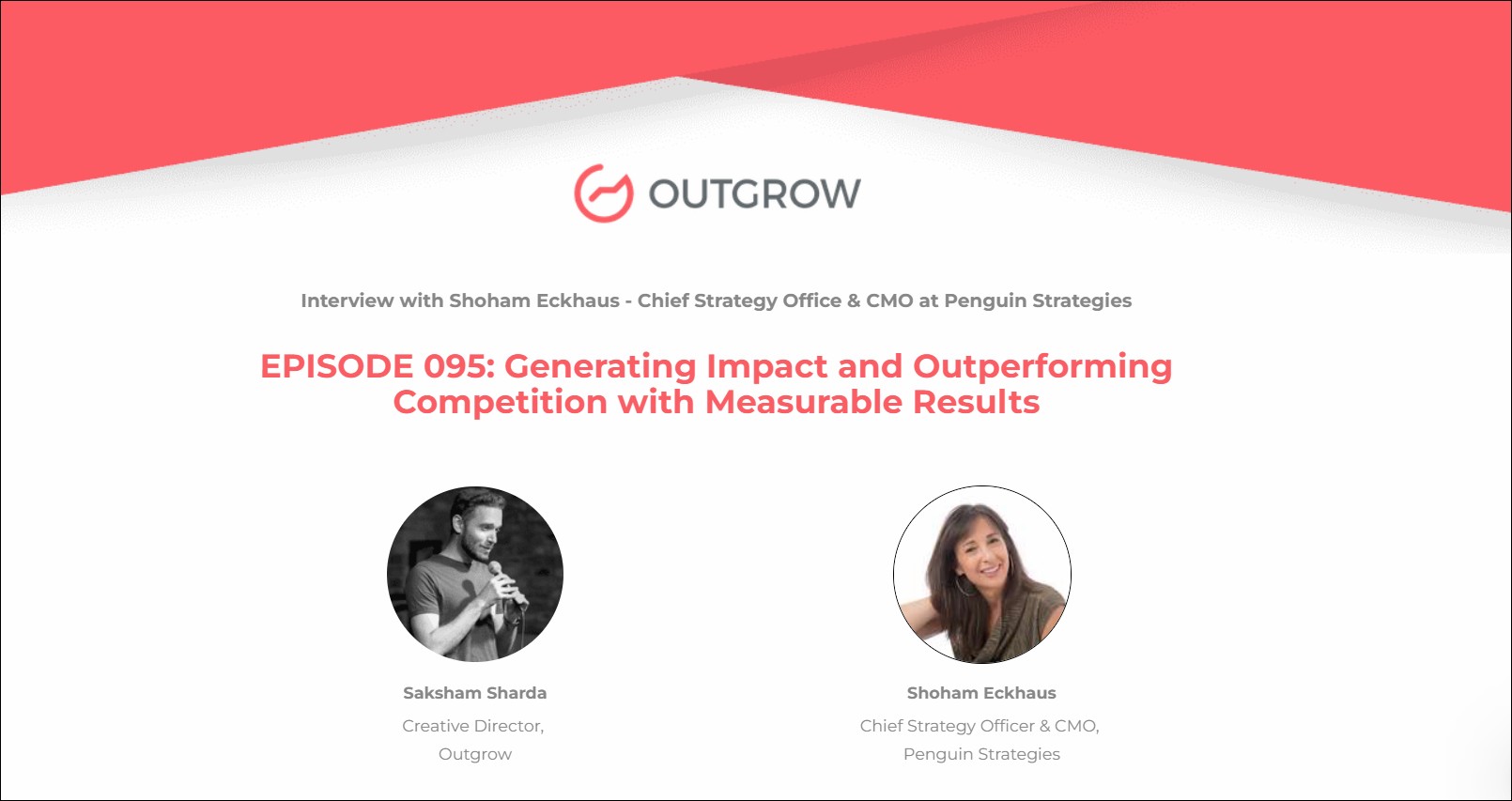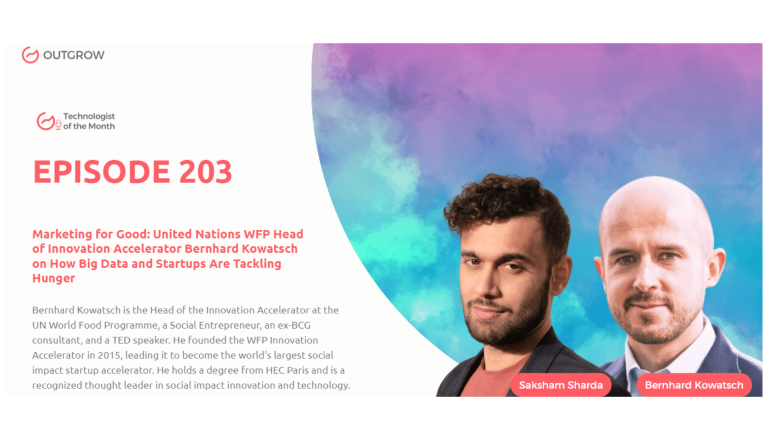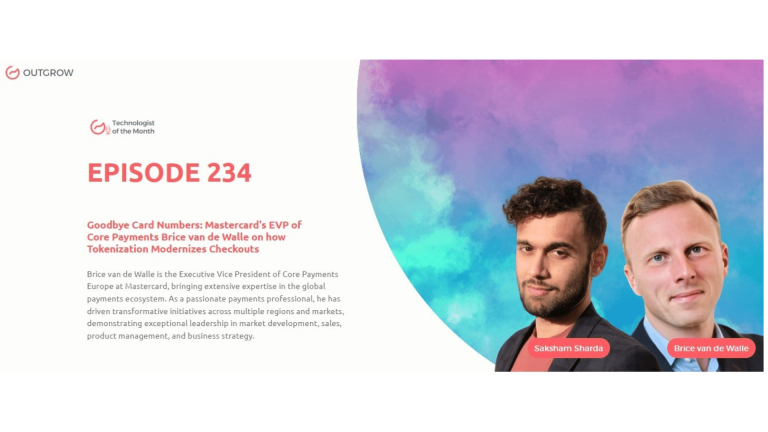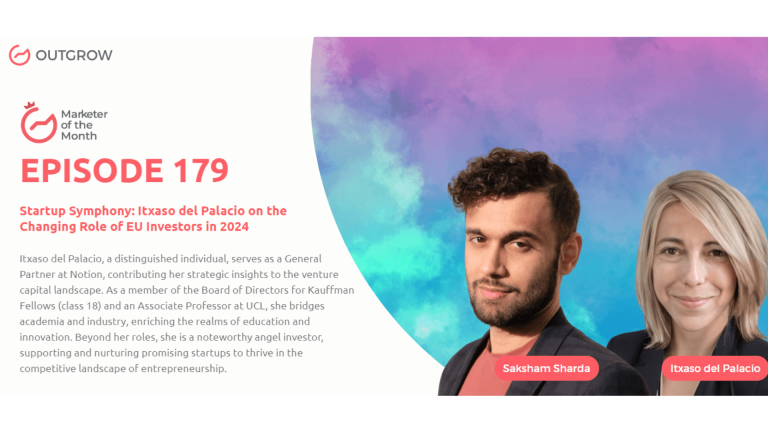EPISODE 095: Marketer of the Month Podcast with Shoham Eckhaus
Table of Contents
Hey there! Welcome to the Marketer Of The Month blog!
We recently interviewed Shoham Eckhaus for our monthly podcast – ‘Marketer of the Month’! We had some amazing insightful conversations with Shoham and here’s what we discussed about –
1. Building an effective marketing funnel for B2B
2. Capturing and converting leads with little effort
3. Relying solely on paid marketing campaigns
4. Optimizing your customer acquisition funnel: The Dos and Don’ts
5. Predictive Marketing and the Future of AI
6. Expanding to a new product under the same brand
About our host:
Dr. Saksham Sharda is the Chief Information Officer at Outgrow.co. He specializes in data collection, analysis, filtering, and transfer by the means of widgets and applets. Interactive, cultural, and trending widgets designed by him have been featured on TrendHunter, Alibaba, ProductHunt, New York Marketing Association, FactoryBerlin, Digimarcon Silicon Valley, and at The European Affiliate Summit.
About our guest:
Shoham Eckhaus is the chief strategy office & CMO at Penguin, a B2B Tech Digital Marketing agency. She is a B2B Growth Hacker, passionate about helping tech companies build and maintain effective “marketing machines”. An entrepreneur, marketer, product manager, system engineer, and yogi – Shoham is a seasoned strategist and an established industry professional with a career spanning decades of experience.
Generating Impact and Outperforming Competition With Measurable Results
The Intro!
Saksham Sharda: Hi everyone, welcome to another episode of Outgrow’s Marketer of the Month. I’m your host Dr. Saksham Sharda, I’m the Creative Director at Outgrow.co. And for this month we’re going to interview Shoham Eckhaus the chief strategy officer & CMO at Penguin, a B2B Tech Digital Marketing agency. Thanks for joining us, Shoham.
Shoham Eckhaus: Thank you for inviting me.
Don’t have time to read? No problem, just watch the Podcast!
Or you can just listen to it on Spotify!
The Rapid Fire Round!
Saksham Sharda: At what age do you want to retire?
Shoham Eckhaus: I want to work less but never retire
Saksham Sharda: How long does it take you to get ready in the mornings?
Shoham Eckhaus: If I count my yoga practice in the ready in the morning then it’s like two hours
Saksham Sharda: The most embarrassing moment of your life?
Shoham Eckhaus: I recall a time that my dad called out my name in front of 4000 people standing silent at a horrible ceremony graduation.
Saksham Sharda: Favorite color?
Shoham Eckhaus: Purple
Saksham Sharda: What time of day are you most inspired?
Shoham Eckhaus: Get my best ideas during my shower in the morning
Saksham Sharda: How many hours of sleep can you survive on?
Shoham Eckhaus: Try not to test it, I try to sleep more.
Saksham Sharda: Fill in the blank: An upcoming Marketing trend is _________.
Shoham Eckhaus: I usually don’t like trends but you know, high intent campaign focus is something that I hear a lot in the last quarter and it’s misused often so we can talk about it later
Saksham Sharda: The city in which the best kiss of your life happened?
Shoham Eckhaus: I’d get in trouble with my husband if I don’t say Tel Aviv
Saksham Sharda: Pick one Mark Zuckerberg or Jack Dorsey?
Shoham Eckhaus: Neither
Saksham Sharda: The biggest mistake of your career?
Shoham Eckhaus: I think it would be waiting too long to start my own business.
Saksham Sharda: How do you relax?
Shoham Eckhaus: I do yoga
Saksham Sharda: How many cups of coffee do you drink per day?
Shoham Eckhaus: One
Saksham Sharda: A habit of yours that you hate?
Shoham Eckhaus: I’m working on myself to stop dumping into people’s words, which is an Israeli culture sort of normal, but with others, it’s terrible.
Saksham Sharda: The most valuable skill you’ve learned in life?
Shoham Eckhaus: I think it’s it trusting my gut feeling. It never lies, usually doesn’t lie.
Saksham Sharda: Your Favourite Netflix show?
Shoham Eckhaus: I haven’t watched Netflix in a while. But the one thing that comes to my mind that I loved was a series by Michael Pollan called Cooked, a short gorgeous series. Highly recommended, especially to people who love cooking.
The Big Questions!
Saksham Sharda: Can you introduce your approach to how a marketing leader should go about building an effective marketing funnel for B2B?
Shoham Eckhaus: Okay, this is a very, very big question, but I’ll try to make it like useful comments about this. Because to teach the whole theory, we would need, you know, a very long time, but then the fundamentals are that you need to understand your customer journey. That’s I’m sure everybody knows that they need to understand it. The thing is that not many companies that I work with, and usually we work with B2B tech startups, not early stage necessarily when I say startups, I refer to companies who are looking for hyper-growth, who are in growth mode. So we work with companies that are in more of the beginning stages around a but also companies that are all later on already with a highly developed marketing funnel and need optimization. And what’s common to 90% of the companies that I come across is that the marketers that we work with, understand the customer journey, they understand the bottom of the funnel well, and they don’t understand very well- the top of the funnel. And the reason for this is that usually, the team has experienced talking to people who are reaching out to them who are getting in front of them. So it’s easy to get a good understanding of what people who are at the bottom of the funnel, what their worldview is, because they talk to a lot of these, they interact with them extensively. So they understand their worldview, what they often don’t understand is what is the worldview of all of the people who are not yet in their funnel, not yet aware of them, not yet, at all looking for solutions in their space. And that is an important part of the journey that you need to figure out, you need to get into the mindset of these people to bring more people into your funnel. And that’s a challenge. And one of the reasons why it’s a very big challenge for b2b technology companies is that, unfortunately, I’m saying that a majority of the marketers that we meet are not highly technical, they’re not necessarily very intimately in conversing with their target audience, because often the target audience would be highly technical people CEO, or chief architect of systems or some very educated professional, where you’re selling to them, the technology. And the marketers are not the ones leading the conversation with those, so they often don’t have a deep understanding of the journey. So the first thing that we suggest to them to do when we start working with it is to get in front of the prospects, the targeted personas. And if they need help in diving into a deep conversation with these people, we suggest to they combine arms with their product management team and engage in what we call audience insight research so that they understand the buying journey from top to bottom. And understanding I mean, understanding the worldview of the people that they want to sell to, and only after you understand their worldview, then you can generate campaigns that have content assets that will appeal to them. So another reason that this is a big challenge, is that often marketers today are under a lot of stress to deliver results quickly-quickly. And companies in their management sometimes underestimate the value of the results of this research stage. So they’re in a hurry, they push them to run campaigns, run campaigns. And I cannot overstate the importance of doing this audience research to understand the worldview of the personas. So that’s the most important part of the beginning.
Saksham Sharda: So when it comes to B2B is it accurate to say that starting a B2B business only through paid marketing campaigns is extremely difficult?
Shoham Eckhaus: First of all, I talk mainly about b2b Because this has been my craft for the last 30 years of my life. And it applies especially to b2b because in b2b, if you’re selling to software programmers, and you are personally not a software programmer, you will never get into their mindset if you don’t interview a lot of them intimately. Or, at least have somebody else in your company interview them intimately and understand their worldview. So of course, it applies to b2b Starting a business based on paid, I have not yet come across a company that worked this way and succeeded. So I don’t want to say that it never exists. The scenario, I’m sure it might exist, but the types of companies that I work with, which are usually companies who are developing technology and selling it to enterprises, those companies, if they start with only a paid approach, which some of them initiate that sometimes in the beginning, and it makes sense to do some of that in the beginning, of course, but if they base their main strategy on that, just think this is something that another competitor, if you’re in a good space, you’ll have competitors, right. So your competitor will see what you’re advertising. If they have deeper pockets than you, they’ll bid more. So they’ll win the traffic, they’ll capture the demand better than you because they have deeper pockets and more money they pour at it, then you start a bidding game you each bid against each other. And there’s no room for a huge ramp-up this way. This is not a great way to do to build a business. So if I were an investor, I wouldn’t invest in such a company. So that’s why startups are usually smart, they know that. So, at least the companies that I work with never met a company that does only that. Although a paid acquisition is effective in settlement and learning fast. So sometimes, it’s the best tactic to apply when you want to learn some things quickly.
Saksham Sharda: What are the most common mistakes that SaaS marketers make when trying to optimize their customer acquisition funnel?
Shoham Eckhaus: Okay, I’m biased to what I’m seeing in the last couple of months, a lot of so I’ll talk about that, especially because, say, we’re now seeing companies go through this phase of uncertainty, and a mode of a lot of budgets being reduced and HR being reorganized or a cut-down. So this is the environment. And it just says, of course, puts more pressure on the CMO to bring results fast. Okay, so, number one most common mistake that I see a lot of right now recently is that companies come to us they say, “Okay, we want to focus on high intent prospects, meaning, don’t bring me the top of the funnel, I don’t want to now put a lot of effort into demand generation, bring me the high intent”. High intent means people who are ready to buy because I need to close deals fast. That’s the pressure that the CMO is under right now more than ever, in the last three years. And the mistake here is that if nowadays, you put more of your efforts into demand capture and capturing high intent, you are again, you’re in a bidding war with other companies who are kept trying to capture the same demand. And you can only be as successful as the number of people who are looking for your thing. And that is often in our when the market is in decline all over the overall demand is down a little bit, or sometimes a lot. So the whole demand is short as the smaller companies are hysterically bidding around it. And there’s no way to grow, the right way to do it is to invest in things that are going to differentiate you. And that is going to be a little bit different than what others are doing. And creating new demand and creating new demand. In that sense, you need to be agile, and creative, go out and seek ways to get in front of new people, get in front of them through new ideas that you maybe didn’t use before, and use triggers of interest that are original. And that’s where innovation comes in. And innovation is super important. So that’s like one very, very common mistake that I see companies doing. And another mistake is that they reach out to people too quickly. So they run a campaign. They get people to sign up on a lead form because they downloaded an ebook or they used a calculator or they signed up for a webinar. And so right after the person fills in their details, the SDR team jumps on them and calls them that is often a way to burn out your list so because just think of yourself like listeners would think of themselves. If they downloaded the ebook that doesn’t mean they want the salesperson to call Little, or throw even reach out to them. So again, circling back to the, you know, you need to invest more in nurturing and bringing value to your audience so that they learn that they appreciate your brand more. And people today more and more rely on piers that the recommendations to them more than before the trust issue today is more important than it was before. Now in times of uncertainty, people want to stick to highly trusted brands. So if you’re a brand that’s not familiar, and somebody just came across your acid and downloaded it, it doesn’t mean they trust you yet. Remember that they don’t trust you yet. So don’t burn them by reaching out to them too early. So that’s another very, very common mistake. And also another very, very common mistake is that they don’t invest enough in talking to clients. That’s the most common mistake of marketers because it’s so difficult for them in the areas that I work in if you’re selling technology, the marketer needs to be very educated on the technology, and sometimes they’re not. So my advice to them, in this case, would be to team up with your product manager, who will also want these insights, and go talk to customers together. That’s, my advice.
Saksham Sharda: What is something that most marketers believe is a mistake, but you believe that it’s not?
Shoham Eckhaus: A lot of people have conceptions about what’s right and wrong. I’ll tell you an example. People have been taught in the last few years that everything they do needs to be data-oriented, and data-driven, you need to all their decisions need to be all database, all decisions. And, I’m a very, you know, analytic person, I love it. Looking at the data, learning everything we can from the data, using AI tools, where you can analytic tools, BI tools, it’s great. But especially in b2b, when you are looking at very niche audiences, the data that you have is very limited, it’s not big data, it’s small, think of most of our clients, they’re marketing to a group of very niche professionals. And those might be, you know, a group all over the world of 300 people, or it might be all over the world 1000 people of this sort. And if you want to get in front of such people, it takes a lot of time to get in front of the majority of these people. And so if you try to be data-driven about every decision you make in marketing, you’re gonna miss out on opportunities to impact some influential people quickly. Although your data doesn’t show that this is a good sign. So and maybe I’ll connect to the item that you asked me in the first part, you asked me about what’s the tool that I again, most important, and I said my gut feeling trust my gut. And I think I’d apply it here also, where, if you’re, if you understand your market and your audience, and do our talking to them, then I think qualitative insight is underrated. So to answer your question back simply the mistake people make, which is the thing that people are? Yeah, what you asked about the something that people think is a mistake, which I think it’s not, it is to make decisions, even if you don’t have the data. That is not a mistake. Because in the early stages of companies, especially in b2b, they don’t have the massive data because they’re getting in front of a few people. And the challenge, in the beginning, is to recruit early adopters. And even if after you recruited a few early adopters as your clients, you’re now trying to get the next circle of people and it’s not masses. So if you run a campaign, and you got just a handful of people responding to your campaign on LinkedIn, for example, it might seem to you like it’s, you know, you’re not getting the ROI because it costs you $400 for a conversion. But what you are, you might be identifying, and not through the data, but through qualitative identification is that some really interesting people are responding to you in some way. Or you got a phone call, like two days after you posted that on LinkedIn, from somebody super important, that told you that they heard from somebody else on your LinkedIn network that they said something about you. And that might be a signal, that’s insightful. So in the early stages, before you have the more massive data, those are invaluable cues that you need to live tune into.
Saksham Sharda: When is it better for a B2B business to hire an agency for its growth rather than grow an organic team?
Shoham Eckhaus: And, of course, I’m not 100% objective on this, but I will say this, they quite objectively that it depends on the company. And then the people that are in the company. So if somebody’s managing marketing, and they first need to look at their resources, their existing team, and see what are the strengths that are existing in their team. Now it fits a startup, usually, they don’t have a huge team. And then they start with just 1-2-3 just a few people. So a few people can’t cover all the professions, all the expertise needed in marketing. And in that case, it makes a lot of sense for the startup to hire outsourced resources to cover specialized areas where they’re not well covered within the company. And for the long term, like for more advanced companies that have bigger teams, I still find that in their niches. It’s Very often, the best result will be to outsource to help the agencies. And the reason is that I’m seeing lately a lot of companies who struggle to hire talent in specific game marketing professions. Finding someone who’s super knowledgeable, and experienced in SEO and PPC, in creating content of a specific sort in people who are highly proficient in specific social channels, and so on, finding that talent is difficult. Because professionals are good. They often don’t want to work for one company, they prefer a variety of companies to work for. And I know that in my company, even we have people that are experts in different fields that are working for Penguin, and we also have a circle of freelancers, that are experts in different things, that we have access to these people, we work with them regularly. And these are people who a startup would love to hire, but they could never hire them. So I think there are different reasons to go for an agency. And it’s very individual for the company. Of course, for the very core strategic functions. If I were now a CMO of a startup of b2b startup, some functions, I would want to be in-house for sure. Product Marketing, for example, often you need somebody in the house that’s in the depths of the understanding of your product and other areas. As you grow, you decide what areas are strategic for you, and those are the areas where you need in hiring in-house people but there are pros and cons, of course. So it depends on what is strategic for you. But I think that if a company, I identify as someone who can be a great evangelist for them, whether they write themselves or brief others, but an evangelist who can carry the leadership role for the content marketing, that is essential and strategic, not all companies and startups especially have the privilege of identifying such a person and having them in house. It’s a challenge, and it’s an important one, but I mean, that’s one of the functions that I would put on the top of the list for in-house.
Saksham Sharda: For an existing B2B SaaS company with an established product, should they expand to a new product under the same brand, or should they build a whole separate brand for a new product? How should they balance the investment between the two products?
Shoham Eckhaus: This also depends sorry, that most of my answers is depends. But here’s another mistake that is often taken by startups. At the beginning of their journey as they’re figuring out their product market fit and as they’re starting to build their marketing funnels, they often have some alternative paths that they are in considering. And the most common mistake that I see in this sense is that they don’t decide on one way or another, but they decide to go both ways, okay? Because they don’t want to they’re not sure which will be better. So they go both ways, or sometimes even more than two ways, two different strategies or two different segment focuses or two different products, whatever. And the direct result of that is that you’re splitting all of your effort, all your resources into two spears instead of one. So in some cases, it makes sense to split into two because you have each of them individually has a really good business case and a good solid strategy that makes sense. But that is not the common case. The more common case that I encounter is where a company is keeping to alternative products and going with two spears because they’re not sure which will be more successful. And as a result, they are dividing their efforts, instead of taking everything that they have and focusing it on one main direction, sometimes it is the right move because you want to, you know, lower your risk, but you’re not sure. So for a while, sometimes it’s the right move to keep two products alive or two strategies alive for a while until you make the decision. But companies need to do to understand that the result of this is that all of your efforts, including your marketing efforts, are divided into two and so it’s half power, often. Now, this relates to your question about branding. So if a company has a brand and now they have two products, should they brand each product separately? The answer is, it’s better if they don’t need to, it’s much better if they don’t need to if both of the products can be all, you know, marketed under the same brand it’s better because then all of your efforts are you know, if you’re you’re working towards brand awareness, you don’t want to divide the brand awareness into two brands. You prefer to put all of it into one bread. But in some cases, it doesn’t make sense because let’s say the two products are not complementing each other they’re even sometimes damaging each other as a brand because one is the low-end product one is the high-end product for example, and you don’t want to influence the brand identity of one with the other so sometimes you have to separate but it’s a privilege that the companies that are very well funded couldn’t have a not most startups shouldn’t go that path if they can.
Saksham Sharda: What would you be doing, if not all this?
Shoham Eckhaus: First of all, I love what I do. I’m an engineer and also a creative person. So I’m guessing if I weren’t a marketer, I would be pursuing some other creative career, maybe an architect, maybe an artist.
Let’s Conclude!
Saksham Sharda: Thanks, everyone for joining us for this month’s episode of Outgrow’s Marketer of the Month. That was Shoham Eckhaus, who is the chief strategist at Penguin, a B2B Tech Digital Marketing agency. Check out the website for more details and we’ll see you once again next month with another episode.









